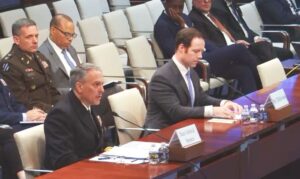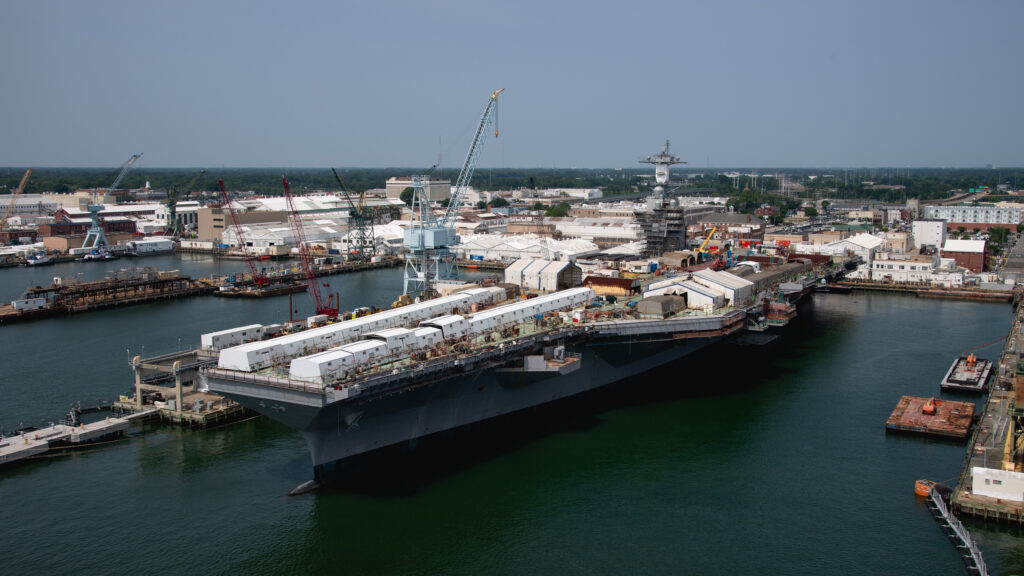Defense Daily
-
 Air Force
Air ForceMissiles and Munitions Top USAF Unfunded Priorities List
Missiles and munitions dominate the U.S. Air Force’s fiscal 2026 unfunded priorities list (UPL). At the top is $300 million for the AIM-260 Joint Advanced Tactical Missile (JATM) by Lockheed […]
-
 Congress
CongressHouse Panel Continues Probe on Counter-Drone Efforts at U.S. Bases
Last month, Rep. William Timmons (R-S.C.), the chairman of the House Committee on Oversight and Government Reform’s military and foreign affairs panel, asked DoD, the Department of Justice, and the […]
-
Wednesday, July 9, 2025
- Second Ford-Class Carrier Running Another 20 Months Late, Third Adds 10 More Months In Budget Books
- Army Aims To Deliver 10,000 Small Drones Over A Year That Each Cost Under $2,000
- Group of Retired USAF Flags Urge Continuation of Wedgetail, Increased F-35 Buy
- Trump Confirms U.S. Has Resumed Sending ‘Primarily’ Defensive Weapons To Ukraine
- Lockheed Martin Helping Havoc AI To Speed USV Development
- Imagery Support for Ukraine in “Early Access” Agreement by BlackSky
- SDA Names Dr. Gurpartap Sandhoo as New Deputy Director
- Maxar Nabs $205 Million In International Contracts For Defense And Intel Capabilities
-
Wednesday, July 9, 2025
- Second Ford-Class Carrier Running Another 20 Months Late, Third Adds 10 More Months In Budget Books
- Army Aims To Deliver 10,000 Small Drones Over A Year That Each Cost Under $2,000
- Group of Retired USAF Flags Urge Continuation of Wedgetail, Increased F-35 Buy
- Trump Confirms U.S. Has Resumed Sending ‘Primarily’ Defensive Weapons To Ukraine
- Lockheed Martin Helping Havoc AI To Speed USV Development
- Imagery Support for Ukraine in “Early Access” Agreement by BlackSky
- SDA Names Dr. Gurpartap Sandhoo as New Deputy Director
- Maxar Nabs $205 Million In International Contracts For Defense And Intel Capabilities
-
 Army
ArmyArmy Aims To Deliver 10,000 Small Drones Over A Year That Each Cost Under $2,000
The Army has laid out plans to deliver thousands of small drones over the next year, with an interest in systems that each cost less than $2,000. A new sources […]
-
 Navy/USMC
Navy/USMCSecond Ford-Class Carrier Running Another 20 Months Late, Third Adds 10 More Months In Budget Books
The Navy’s fiscal year 2025 budget request shipbuilding budget documents revealed the next two Ford-class aircraft carriers will be another 20 and 10 months late, respectively. The future USS John […]
Tagged in: -
 Business/Financial
Business/FinancialLockheed Martin Helping Havoc AI To Speed USV Development
HavocAI on Tuesday said it is collaborating with Lockheed Martin’s [LMT] Ventures unit to accelerate the development and production of autonomous medium unmanned surface vessels (mUSVs). Lockheed Martin Ventures typically […]
-
 International
InternationalTrump Confirms U.S. Has Resumed Sending ‘Primarily’ Defensive Weapons To Ukraine
President Donald Trump on Monday confirmed the U.S. has resumed sending “primarily” defensive weapons to Ukraine. “We’re going to send some more weapons. We have to. They have to be […]
-
 Space
SpaceSDA Names Dr. Gurpartap Sandhoo as New Deputy Director
The Space Development Agency (SDA) has named Dr. Gurpartap “GP” Sandhoo as the new deputy director, with the departure of Deputy Director Ryan Frigm. SDA announced Sandhoo’s appointment on July 8. He […]
-
 Air Force
Air ForceGroup of Retired USAF Flags Urge Continuation of Wedgetail, Increased F-35 Buy
A group of six former U.S. Air Force chiefs of staff and 13 other retired Air Force generals are urging Congress to fund Boeing [BA] E-7 Wedgetails to replace the […]

